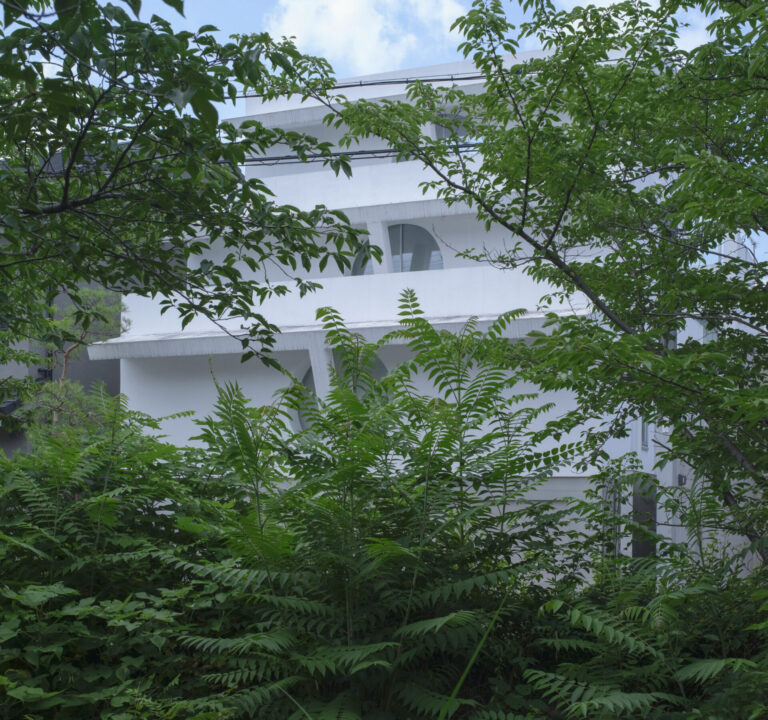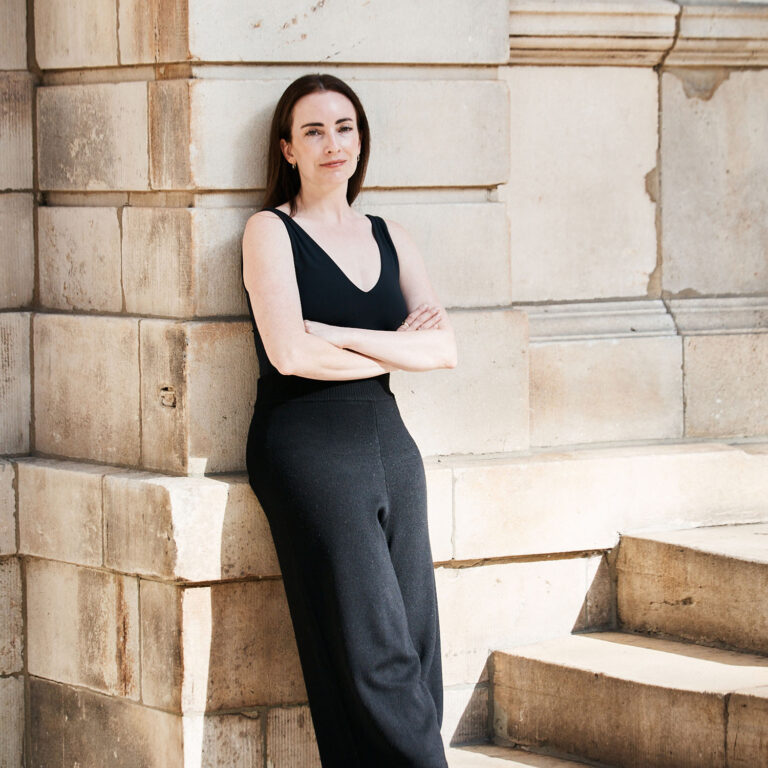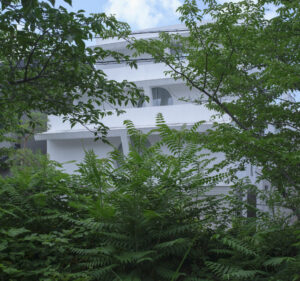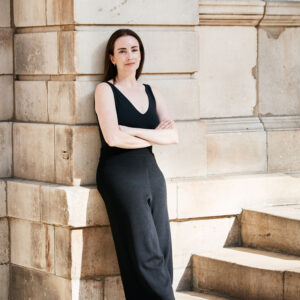
Dani Karavan is an Israeli artist celebrated for site-specific monuments and environmental sculptures. Though many of his commissions relate to historical or political events, his large-scale pieces champion mankind rather than a national agenda. Karavan expands the boundaries of human perception and artistic practice by merging sculpture, architecture and landscape. With three exhibitions in Europe this fall, the artist talks with Lily Kwong about the principles that have driven his five decades of practice.
With a background in sculpture and painting, what led you in the direction of creating site-specific art? I began studying painting when I was 13 years old and wanted to become a painter. In my youth I was part of political movements involved with human rights and peace. During the cease-fire of the War of Independence (1948) I was among the founders of a kibbutz on what was then the border with Jordan. As a member of the kibbutz I became interested in doing art for the general public rather than for private people. During this period, I started to think about painting murals as public art. I then decided to travel to Florence and study fresco. I was very much influenced by 13th- and 14th-century art in Italy, especially in Tuscany. When I returned to Israel, I understood that I would not be able to do fresco paintings due to the widespread use of cement in modern construction. I wanted to find a way to combine the techniques of murals with the materials used in contemporary architecture. Therefore, I began working in concrete and created large-scale bas-reliefs for public buildings. At the same time, I was also designing stage sets for the Cameri Theater in Israel and various dance companies, including the Martha Graham Dance Company in New York. Following my experience with the site-specific bas-reliefs and with set design, I was invited to create site-specific sculptures, which best suited their environment. I was lucky to get commissions in Israel and, following those, in different countries all over the world.
Your father was the chief landscape designer for Tel Aviv from the 1940s through the 1960s. How did that influence your approach to your practice? I began to understand how much I was influenced by my father, Avraham Karavan, only when I turned from painting to sculpture. My father grew up in Manchester and I think he was very inspired by the English gardens. He always wanted to recreate nature—gardens as nature. I understand now that I am following his footsteps: When I approach a site, I often develop the project in a very similar way to his way of creating gardens.

What do you believe the role of the artist is in urban life? Artists working in an urban environment have to take people into consideration. They need to always keep in mind that the space they are creating has to include people, to make a connection with them. In my site- specific works people are an integral part of the work. My works could not exist without people. I want them to experience the work and feel like it is embracing them. At the same time, I never try to impose the way people should interact with my work. The work itself inspires people and leads them to explore the different forms and spaces. The fact that children engage with my works is not because I designed it for that purpose, but because my works give them a sense of freedom to use them in any way they would like to, without aggression, without violence—in a peaceful way.
Regarding your materials, you list natural elements first like sunlight, water and wind before manmade materials like concrete or steel. Why? When I create an environment, I use materials such as trees, vegetation, flowers, etc. in a similar manner to that of a landscape architect. However, I use them as materials of art. Instead of their botanical use, I use them as a form, color and structure. In my view, it is the site that is looking for the artist and not the other way around. Natural elements and memory create art. Artists should take what nature is proposing them and integrate it into their works.
They have to listen. In all my projects, the site is guiding me. In the White Square in Tel Aviv, for instance, the olive tree, as an organic form, counterpoints the geometric elements. It was artistically necessary to integrate this tree in the work. I wanted to incorporate the surroundings, the park, so that the square will be connected with nature around it. Some say that since I work with harmonious materials my works symbolize peace. But this is not my approach. I don’t use white concrete or water or trees in order to “describe” peace. An olive tree can be used as a symbolic element, but also as a simple artistic material. In fact, any object can be used as artistic material. You can use sand, you can use a tree. The site also dictates the materials. This is why it is important for me to write natural elements before manmade materials.

Your first site-specific environmental sculpture, the Negev Monument (Be’er Sheva, Israel 1963–68), became a landmark in Land Art. How are these human events you are memorializing connected to the natural world? First of all, I am not an artist who creates memorials. I create homages. In 1962, my friend Micha Perry asked me to design a monument to commemorate those who fought in the Palmach Negev Brigade in 1948.
Many of my friends had fought with the brigade. Nahum Sarig, the Negev Brigade’s commander, told me that it was formed before the War of Independence in order to protect the settlements in the Negev and safeguard the water pipeline which was a real lifeline for their residents. Uzi Narkiss, a commander of the Negev Brigade’s Seventh Battalion, suggested I build a lookout so that visitors could climb up and physically experience the landscape. Nature was indubitably inherent to this project! I observed the surrounding hills leading down to the valley, examined the views of the rolling landscape, and studied all the folds of the ground, the rocks and the bushes. All those elements became materials of my art. I had to integrate the landscape of the desert, its particularities, in order to tell the story of this brigade. My father helped me to plant acacia trees, indigenous to the Negev desert. As water was scarce, he knew which trees should be used. He always kept in mind the water. The line of water I created as part of the monument is not only a symbol of life, but also a tribute to the Palmach Brigade who had the mission of insuring the water supply to the kibbutzim in the desert. At the time, I didn’t know what I was doing, I had no theories. I did what I felt. I created a sculpture that directs the flow of visitors to it and requires them to use all their senses. This constitutes the experience—an environment composed of natural materials and memories.

You create in so many different mediums. Is there a common message driving your work? My creative process and its language are defined through a unique and specific relation to the place itself; through a dialogue with the site, with the natural and built environment that surrounds it; through the use of specific materials, wind, sun, water, tree and earth; and through a dialogue with those who commissioned the work. This is how the story is created. I would never go against nature, against the landscape. What I am creating is specifically an opening to a panorama, to a view inseparable from a place. It is crucial to integrate the details of the surrounding landscape into the work. That is why in the Axe Majeur, a site-specific 3-kilometer-long axe I created for the new city of Cergy-Pontoise near Paris, I invite people to climb up a 36-meter-high tower where they can contemplate the beautiful view of the surroundings. In the Negev Monument, my objective was to trap the light and sun, like ancient cultures did in the pyramids. I wanted to hear flowing water, to write on water. When the wind rose and offered its breath into the pipes, it was like flutes— its music could resonate like the melancholic sounds of a Bedouin flute.
In 2016, you requested that your historic Knesset sculpture be taken down in protest, in response to Israel’s Culture Minister launching a new funding criteria that penalized artists who refused to perform in the occupied West Bank. You asked, “What is this if not a dictatorship?” As authoritarian leaders rise across the globe, what do you feel your responsibility is as an artist today? I was born and raised in Israel, where I have always been part of left-wing political movements. When I did this wall for the Knesset, it was an homage to the first declaration of independence of the Israeli state, which was genuinely a text promoting respect for human rights. As the current political ideology in Israel is far from this text, I decided I wanted to remove my work from the Knesset so that it will not be related to what I have always been fighting against. I am very concerned and very worried about the politics around the world. The worst part is that I don’t see how it would change positively. I have always believed in rights for everyone. The French motto “liberté, égalité et fraternité”—liberty, equality and brotherhood—really resonates in me. Indeed, I feel very close to it. Unfortunately, it seems like this is a right we are losing day by day. I believe that artists today have the responsibility to promote the fact that we all have the right to express our beliefs and in the same time we should not impose them on others. We have to listen to each other. Freedom of speech is essential. Evelyn Beatrice Hall wrote about Voltaire’s way of thinking: “I disapprove of what you say, but I will defend to the death your right to say it.” In the Jewish tradition, we are taught to love our neighbors as ourselves. This is what I feel is important to pass on.

Memorials can be the most challenging and fraught commissions an artist can take on. With multiple narratives and agendas surrounding historical events and figures, how do you orient yourself as an artist to a project? When I am commissioned for a site-specific project related to historical events, I always study the different versions of the story by consulting experts, reading articles and all kind of information which allows me to have a clear view on the situation. Then I take from it the most convincing and encouraging message to bring hope to my project. I try to avoid political messages as much as possible so that my work is not related to nationalistic ideas. My project is about men and mankind first. I always carry a message of peace, mutual understanding and freedom through the story of those I pay tribute to, so that they will be remembered in the future. Nowadays there is less and less respect between people. Less and less people care for others’ lives. Furthermore, in the current political situation around the world—with far-right political parties speaking in their own voice and governments that wish to change the history— it is even more important for me to convey the courage and the story of those who lived through the worst. I make sure the message is clear, that the history is not altered and I prevent any ambiguity. That is where natural elements play an important part in my work.
You cannot misinterpret an olive tree, the sound of the waves breaking or rays of sunlight reflecting on water. The best result is when nature itself can tell the story. For example in my homage to Walter Benjamin in Portbou I was looking for the right way to represent the turbulent life of this important Jewish philosopher. When I saw the whirlpool the waves made in the sea, it was clear for me that this was the essence of my project. The whole project is then directed towards this whirlpool.

What are your values as you approach these sensitive projects, and do you have a different approach when an event includes death? Most of my works are commissions that involve tragic events. Therefore I have to deal with death but also with life, as they are closely linked to one another. Obviously, I have great respect for these people who were killed and I want to honor them in my work. However, it is crucial for me not to treat them as heroes. Indeed, I want to avoid creating feelings of holiness or religious explanations of any kind towards them. It is more important for me to point to their admirable humanistic values, just like Walter Benjamin in my work Passages or the Sinti and Roma in the memorial in Berlin. I always try to create spaces that celebrate life rather than death. Even places of memorial can give a feeling of the importance of life.
You recently opened some major exhibitions. Tell us about them. How do you approach showing your work differently in a gallery context? My exhibition in Paris at Galerie Jeanne Bucher Jaeger is called “Adama,” which means “earth” in Hebrew. It also has in it the word “Adam,” which in Hebrew not only relates to the first man but to all human beings, and the word “dam,” which means blood—the fluid of life. The Jeanne Bucher Jaeger gallery has been my home since I arrived in France in 1980 to work on the Axe Majeur. In the exhibition, I will show a model of the Axe Majeur that is more than eight meters long, as well the earth sculptures and bas-reliefs I created in 2015 as a comeback to work exclusively with natural material. It is a reference to the houses and villages which are made from earth. I came back to the traditional building techniques of my ancestors who lived 2,000 years ago in the country where I was born.
On the occasion of the 25th anniversary of my monument the Way of Human Rights in Nuremberg, which was in October, I received the Nuremberg honorary citizenship and I opened an exhibition at Kreis Galerie there. It was an opportunity to present a model, films and installations related to this very important work of mine. Following this work was the initiation of the Nuremberg Human Rights Prize, awarded every two years to freedom and equality fighters who risk their lives but are still anonymous. Later that month I opened a third exhibition, this time in Italy, in the Museo Nazionale dell’Ebraismo Italiano e della Shoah in Ferrara. This exhibition introduces to the public the site-specific project I have been wanting to create in Ferrara: Il Giardino che non c’è (“The Non-Existent Garden”) as an homage to Giorgio Bassani’s book “The Garden of the Finzi-Continis” (“Il giardino dei Finzi-Contini”). Indeed, this garden does not exist in reality, although I have seen tourists looking for it. Some of my main works are also on display there, such as Passages in Portbou, the Way of Human Rights in Nuremberg, the Sinti and Roma memorial—all linked to memory and human rights.

What is your hope for humanity now? I hope people will be more tolerant of others and to each other. I hope for more education all around the world. I hope that in most countries, art will have a key role in people’s daily lives.










 in your life?
in your life?

